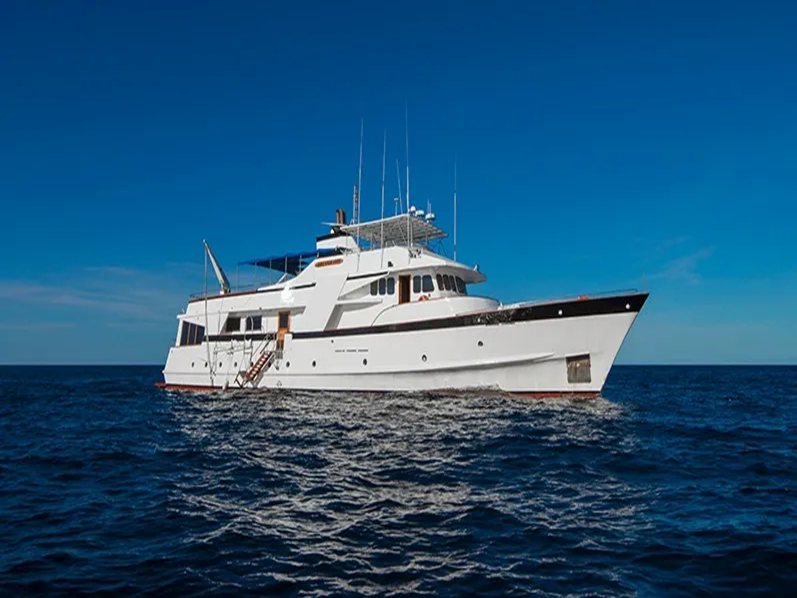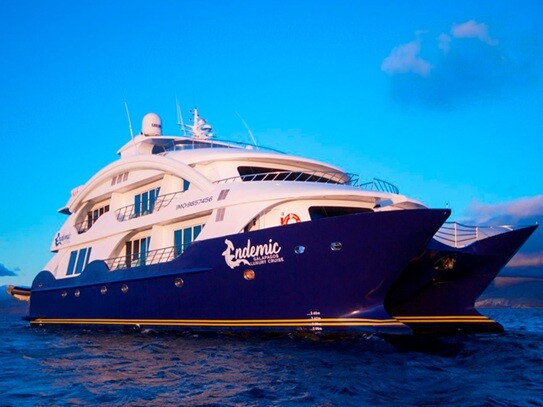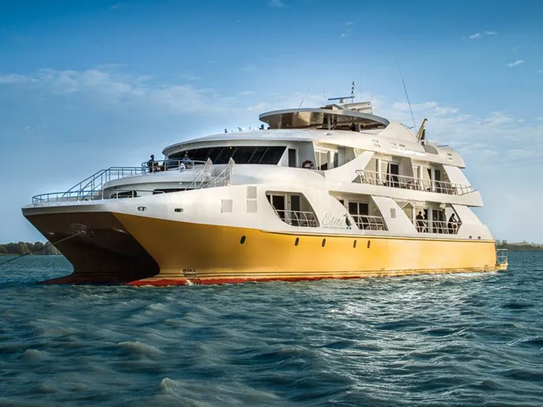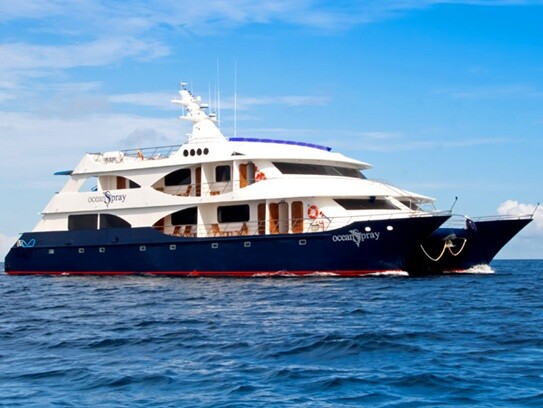- Specifications
- Fernandina Itinerary (8D / 7N)
- Isabela Itinerary (6D / 5N)
- Tower Itinerary (8D / 7N)
- Hood Itinerary (6D / 5N)
- Trip Includes
- Trip Excludes
- Gallery
- FAQ
- Availability
| Category | Superior First Class |
| Capacity | 16 passengers |
| Length | 110 ft. |
| Beam | 23 ft. |
| Cruise Range | 12 knots cruising |
| Type | Motor Vessel, Steel hull |
| Cabins | Cabin 1 - Triple with 2 lower and 1 upper Cabin 2 - Twin with 2 lower Cabin 3 - Double with 1 matrimonial Cabin 4 - Twin with 2 lower Cabin 5 - Double with 1 matrimonial Cabin 6 - Twin or matrimonial with 2 lower that can be joined Cabin 7 - Twin or matrimonial with 2 lower that can be joined Cabin 8 - Twin with 2 lower |
Fernandina Itinerary
| Day | Activity |
|---|---|
| Day 1 (Wednesday) | Arrive at Baltra Airport / Santa Cruz Island Santa Cruz Island: Highlands of Santa Cruz: Galapagos giant tortoises can be seen in the wild in the highlands of Santa Cruz. Charles Darwin Station: Visit the Charles Darwin Station, a research facility and National Park Information center, with a breeding program for giant tortoises and land iguanas. |
| Day 2 (Thursday) | Sombrero Chino Island / Rábida Island Sombrero Chino: A small volcanic island near the southeast tip of Santiago. The island's name comes from its shape. Wildlife includes sea lions, marine iguanas, and the Galapagos penguin. Rábida Island: Known for its dark red coral sand beach. Highlights include the lagoon with flamingos, pelican nesting site, sea lion bachelor colony, and a snorkeling site at the beach's end. |
| Day 3 (Friday) | Isabela Island (Albemarle) Isabela Island: The largest of the Galapagos Islands formed by five active volcanoes. Wolf Volcano is the highest point at 1707m. Sierra Negra: Features a caldera with a 10km diameter, recent lava flows, highland vegetation, and parasitic cones. Puerto Villamil: A charming town on a white sand beach with highlights including the Tortoise Breeding Station and flamingo lagoon. |
| Day 4 (Saturday) | Isabela (Albemarle) Island Elizabeth Bay: Only accessible by dinghy. Penguins can be seen on small islets, and the bay is surrounded by mangroves with Galapagos sea turtles and rays in the water. Punta Moreno: A site offering spectacular views of volcanoes Alcedo, Sierra Negra, and Cerro Azul, with impressive lava flows and arid vegetation. |
| Day 5 (Sunday) | Isabela (Albemarle) Island Urbina Bay: Located on the central-west coast of Isabela, near Alcedo and Darwin volcanoes. Features colorful land iguanas, Galapagos giant tortoises, and coral uplifting from 1954. Tagus Cove: A natural harbor with historical significance, where whalers and pirates left carvings and ship names. A walk uphill to Darwin's Crater offers an excellent view. |
| Day 6 (Monday) | Fernandina Island / Isabela Island Fernandina Island: The youngest volcanic island in the Galapagos and still active. Punta Espinoza: Known for large colonies of marine iguanas and unique species like flightless cormorants, Galapagos penguins, and hawks. Punta Vicente Roca (Isabela Island): A dinghy ride to cliffs and a partially sunken cave. The shoreline is home to Nazca boobies, blue-footed boobies, and flightless cormorants. |
| Day 7 (Tuesday) | James (Santiago) Island / Bartolome Island James Island: Offers a wide variety of seabirds, marine iguanas, and fur seals. Playa Espumilla: A beautiful contrast of golden beach and green mangroves, home to flamingos, pintail ducks, and green sea turtle nests. Buccaneers Cove: A historical site for Charles Darwin and pirates, offering snorkeling with Galapagos fur seals, brown noddies, and pelicans. Bartolome Island: Famous for Pinnacle Rock and penguins. A hike provides spectacular views, and there’s great swimming and snorkeling. |
| Day 8 (Wednesday) | North Seymour Island / Baltra for return flight to Quito North Seymour Island: Home to endemic Palo Santo trees, blue-footed boobies, swallow-tailed gulls, and magnificent frigate birds. Baltra: Return flight to Quito. |
Isabela Itinerary:
| Day | Activity |
|---|---|
| Day 1 (Friday) | San Cristóbal Island San Cristóbal (Chatham):
|
| Day 2 (Saturday) | Española (Hood) Island
|
| Day 3 (Sunday) | Floreana Island
|
| Day 4 (Monday) | Santa Cruz Island / James Island
|
| Day 5 (Tuesday) | Tower (Genovesa) Island
|
| Day 6 (Wednesday) | Santa Cruz Island / Baltra for return flight to Quito
|
Tower Itinerary:
| Day | Activity |
|---|---|
| Day 1 (Wednesday) | Arrive at Baltra Airport / Santa Cruz Island Santa Cruz Island:
|
| Day 2 (Thursday) | South Plaza Island / Santa Fe Island
|
| Day 3 (Friday) | San Cristóbal Island
|
| Day 4 (Saturday) | Española (Hood) Island
|
| Day 5 (Sunday) | Floreana Island
|
| Day 6 (Monday) | Santa Cruz Island / James Island
|
| Day 7 (Tuesday) | Tower (Genovesa) Island
|
| Day 8 (Wednesday) | Santa Cruz Island / Baltra for return flight to Quito
|
Hood Itinerary:
| Day | Activity |
|---|---|
| Day 1 (Friday) | Isabela Island
|
| Day 2 (Saturday) | Isabela (Albemarle) Island
|
| Day 3 (Sunday) | Isabela (Albemarle) Island
|
| Day 4 (Monday) | Fernandina Island / Isabela Island
|
| Isabela Island
| |
| Day 5 (Tuesday) | James (Santiago) Island / Bartolome Island
|
| Bartolome Island:
| |
| Day 6 (Wednesday) | North Seymour Island / Baltra for return flight to Quito
|
Includes
| ✅ Accommodation (sharing double cabins) |
| ✅ Meals |
| ✅ Purified water |
| ✅ Snacks |
| ✅ Excursions with a naturalist bilingual guide |
| ✅ Wetsuits |
| ✅ Snorkel equipment |
Additional Information
-
Discounts: We offer special discounts for children under 12 (one child per adult maximum), please contact us for these rates. This discount is not applicable over Christmas and New Years departures.
-
Special departures: We do not offer the 6 day cruises over Christmas and New Years departures.
-
Single supplement: 50% increase over sharing accommodation rate
-
Surcharges: Fuel surcharge in effect, $55 for 6 day trip, $75 for 8 day trip. A surcharge of $200 per person is applicable during Christmas and New Years weeks.
-
Flight Costs (not included in Galapagos cruise costs): Contact us for current rates for flights from Quito or Guayaquil to the Galapagos Islands. Our yacht Beluga is scheduled to operate in connection with Avianca airlines.
-
National Park Entrance Fee: US$100 (subject to change).
-
Migratory Card Fee: US$20 (subject to change).
Not Included
| ❌ Air ticket |
| ❌ National Park fees |
| ❌ Migratory Card (US$20) |
| ❌ Bottled and alcoholic beverages on board |
Additional Information
-
Discounts: We offer special discounts for children under 12 (one child per adult maximum), please contact us for these rates. This discount is not applicable over Christmas and New Years departures.
-
Special departures: We do not offer the 6 day cruises over Christmas and New Years departures.
-
Single supplement: 50% increase over sharing accommodation rate
-
Surcharges: Fuel surcharge in effect, $55 for 6 day trip, $75 for 8 day trip. A surcharge of $200 per person is applicable during Christmas and New Years weeks.
-
Flight Costs (not included in Galapagos cruise costs): Contact us for current rates for flights from Quito or Guayaquil to the Galapagos Islands. Our yacht Beluga is scheduled to operate in connection with Avianca airlines.
-
National Park Entrance Fee: US$100 (subject to change).
-
Migratory Card Fee: US$20 (subject to change).
Aboard the Beluga, guests enjoy an intimate and up-close experience with the Galápagos Islands. With only 16 passengers, the yacht allows for exclusive access to the best visitor sites, some of which are closed to larger ships. The journey offers opportunities to spot dolphins, whales, sea lions, and enjoy scenic views from the panoramic windows and sundeck, making it a truly unique way to explore the islands.
The Beluga accommodates a maximum of 16 passengers in 8 double cabins. One of these cabins features an additional berth, making it suitable for families or groups. Each cabin has a private bathroom with hot and cold water showers, ensuring comfort and privacy during the cruise.
The Beluga is a “Superior First Class” motor yacht equipped with modern safety and mechanical equipment. It is fully air-conditioned and has spacious social areas, including a salon with panoramic windows, a dining area, and a large sundeck for relaxation, sightseeing, and sunbathing. These features make the Beluga an ideal vessel for cruising the Galápagos in comfort and style.
The Beluga offers 6-day and 8-day itineraries that visit selected sites approved by the Galápagos National Park. These itineraries provide a rich and varied experience of the islands, with opportunities to explore the islands and enjoy the local wildlife up close. The 6-day and 8-day itineraries can be combined into a 15-day journey for a more comprehensive and in-depth exploration of the Galápagos.
The Beluga is equipped with the most modern safety and mechanical equipment, and complies with all necessary regulations. It is SOLAS (Safety of Life at Sea) certified, follows the ISM (International Safety Management) code, and is licensed to operate in the Galápagos Islands, including the Galápagos National Park Environmental License. These measures ensure a safe and responsible experience while exploring the islands.

























